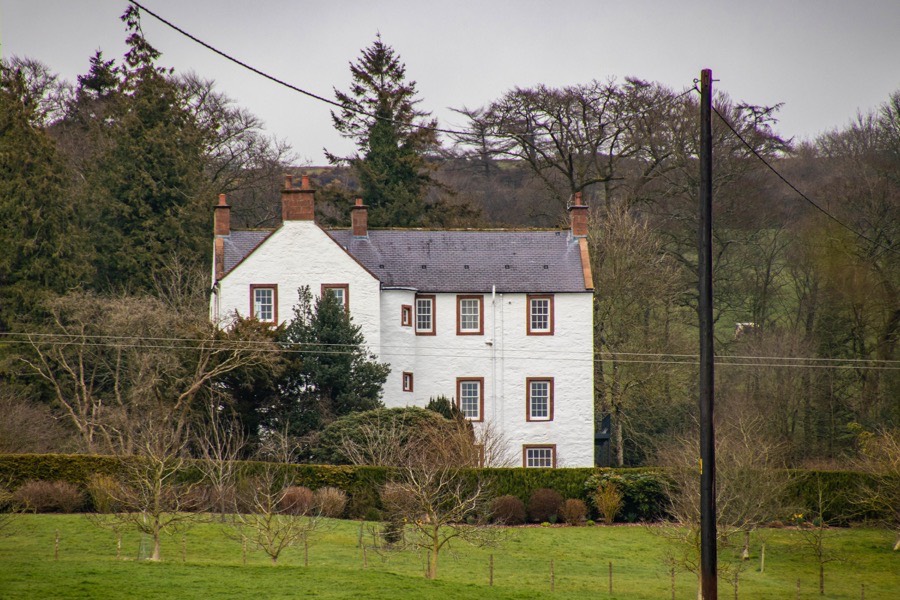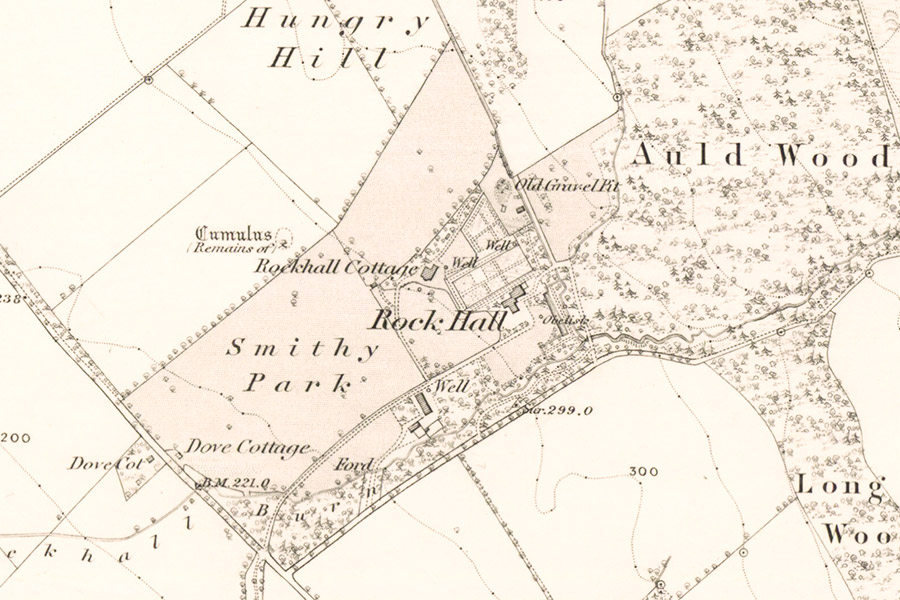

Rockhall is an early 17th century tower house which incorporates earlier, possibly 15th century, work.
The house stands on rising ground just north of the strategic main route from Annan in the east to Dumfries in the west, with an expanse of boggy moorland stretching north, east and south-east. Around 1.1km to the north of Rockhall is Rockhall Mote, the remains of a 12th century motte and bailey castle which Rockhall ultimately superseded.
There was a chapel near Rockhall Mote which is mentioned in 1223 when it was in the possession of William of Glencairn. At the end of the 13th century or the beginning of the 14th Robert, son of Robert de Brus Lord of Annandale, granted the chapel of Rockhall to the church of St Mary of Guisborough.
When the first tower was built at Rockhall is not known, however the estate originally belonged to the Kirkpatrick of Closeburn family. In 1412 Gilbert Grierson, 2nd of Lag, married Isabel Kirkpatrick, daughter of Sir Duncan Kirkpatrick of Torthorwald, and Rockhall eventually passed to their son Vedast Grierson and so into the Grierson family with whom it would remain until the 1950s.
It seems likely that a tower was built either by the Kirkpatricks or the Griersons in the 15th century and this is represented by the westernmost part of the current building. The tower was oblong on plan and aligned approximately north to south. Thick walls enclose a vaulted basement chamber, lit by slit windows, with an internal floor area measuring around 3.7m by 2.7m.
In 1526 James V erected the lands of Rockhall into a feudal barony for John Grierson of Lag. Late in the 16th century the tower was extended to the east, tripling the length of the building, with two storeys over a vaulted basement to match the original tower. Sir William Grierson of Lag was knighted by James VI in 1608 and a sasine by Grierson to his wife, Nicholas Maxwell, daughter of William Maxwell, 5th Lord Herries of Terregles, in 1610 states “All and haill the place of Rockhall laitlie biggit be the said Sir William”. This may refer to the aforementioned extension or possibly to further remodelling early in the 17th century.
A further charter from 1610 states:
luiff and affection quhik of dewtie, I beir to my lovit spouse, Dame Nicolace Maxwell, and calling to remembrance the cair and trubell taen be hir upoun my directioun in the edifeing and bigging of the place of Rockell laitlie constructit be me and in all utheris my honorabill affairis, according to the dewtie of ane loveing wyiff
Sir William Grierson of Lag, 1610
At some point in the 17th century a projecting wing was added to the south side of the east end of the building, with a spiral staircase tower installed in the reentrant angle. The building was entered via a doorway at the bottom of the stair tower at this time. In 1654 Sir William’s grandson, William Grierson of Barquhar, married Margaret Douglas of Mouswald. Their son, Sir Robert Grierson, was served heir to his cousin in 1669, also Robert Grierson, who died as a minor.

Joan Blaeu, Amsterdam, 1654map image courtesy of NLS
Sir Robert, commonly known as Auld Lag or Cruel Lag, fought under John Graham of Claverhouse, 1st Viscount Dundee (Bonnie Dundee), and was notorious for his dogged pursuit of Covenanters. An iron hook in the vaulted kitchen chamber at Rockhall was said to have been used to hang his prisoners.
Late in the 17th century the new wing was extended further to the south. In Sir Robert’s later years he took up residence at Rockhall and died in 1733. He was married to Lady Henrietta Douglas, sister of William, 1st Duke of Queensberry, and they had four sons and a daughter. Their eldest son, Sir William, succeeded his father and at some point during his tenure he seems to have built a “pidgeon coat” at Rockhall as he sent a letter to Sir John Clerk of Penicuik inviting him to view it. The doocot stands just north of the Rockhall Burn and just west of Linns Road, around 300m west-south-west of Rockhall. Sir William died in 1737 and was succeeded by his brother, the fourth son, Sir Gilbert. One of Gilbert’s sons, William Grierson, was a close friend of Sir Walter Scott.

William Roy, 1752 – 1755map image courtesy of NLS
Upon Sir Gilbert’s death in 1766 he was succeeded by another son, Sir Robert, who around 1815 Grierson brought the old entrance gateway from Mouswald Tower to Rockhall which he installed at the stables there. Sir Robert died in 1839 at the age of 103 and Rockhall passed to his son, Sir Alexander, who died the following year. Rockhall then passed to Sir Alexander’s eldest son, Sir Richard, until his death in 1846, then to his second son, Sir Alexander. Alexander Crombie was commissioned to remodel the house between 1854 and 1855.

Ordnance Survey, 1861map image courtesy of NLS
Upon the death of the younger Sir Alexander in 1879 Rockhall passed to his nephew, Sir Alexander Davidson Grierson, who commissioned James Barbour to remodel the interior of the house to better suit modern living, work which was carried out around 1880. The younger Sir Alexander died in 1912 and further alterations were made around 1915 by JM Bowie for Sir Alexander’s son, Sir Robert Grierson, including the creation of a new entrance just to the south of the stair tower, the old entrance presumably being blocked at this time.
Rockhall seems to have been let out by the family as various members of the Reid family seem to have been resident there in the 1920s and members of the Morgan family in the 1930s and 1940s. Sir Robert sold Rockhall in 1951, possibly to the Morgans since a Brigadier and Mrs Russell Morgan lived there in 1959. The house was put on the market in 1963 by Brigadier D.R. Morgan “in whose family it had been for some sour centuries” suggesting perhaps a marriage between a Grierson daughter and a Morgan son.
The house later became a hotel, operating as the Rockhall Country House Hotel, however in 1997 it was converted back into a private family home.
Alternative names for Rockhall
Rocail; Rocall; Rochal; Rochel; Rock Hall; Rock-Hall; Rockall; Rockel; Rockele; Rockell; Rockhall House; Rockhall Tower; Rockhill; Rocol; Rokcale; Rokele; Rokkel; Rokkell














